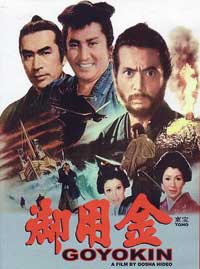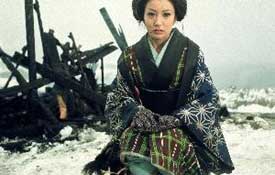 Hideo Gosha's Goyokin (Official Gold, 1969) begins with a narrator providing a bit of history about the gold mining on Sado Island & the periodic shipments of gold bars by sea to the bakufu government in Edo. Along the coastal route was an area of dangerous waters where ships were occasionally lost.
Hideo Gosha's Goyokin (Official Gold, 1969) begins with a narrator providing a bit of history about the gold mining on Sado Island & the periodic shipments of gold bars by sea to the bakufu government in Edo. Along the coastal route was an area of dangerous waters where ships were occasionally lost.
The film proper begins with a pastoral view of a wedding procession taking a young bride across the snow-covered landscape from her home village to the village of her husband to be.
A woman travelling afoot sees the procession in the distance, & is made joyful by the vision because she will soon be reuinited with her own family & will have her own wedding day very soon, after having been away from her village for five years indentured to a weaving factory.
Alas, when she reaches home, she finds everyone in her seaside village missing, with evidence of recent carnage. When next we see her, three years later, she will have become a wandering dicer with a tendency to cheat.
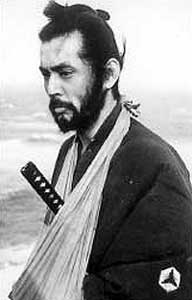 As a mystery unfolds we discover that the distant wedding procession seen at the start was not what it seemed, & we will quite soon know what happened to that fishing village. Our hero, Magobei (Tatsuya Nakadai) happened upon the crime in progress. As a mystery unfolds we discover that the distant wedding procession seen at the start was not what it seemed, & we will quite soon know what happened to that fishing village. Our hero, Magobei (Tatsuya Nakadai) happened upon the crime in progress.
His lifelong friend, brother-in-law & fellow vassal to the local daimyo, has seen to the murder of every villager after the villagers helped recover gold from a sunken ship.
Rather than take the recovered gold to the bakufu government, Tatewaki (Tetsua Tamba) wants to transport it to his own lord's castle, as the clan is desperately in debt due to hindrances from the bakufu. He dares not leave anyone as witness that the gold was even recovered.
Magobei is horrified by the slaughter of honest fishermen & their families. If the bakufu found out what had happened, his clan would be abolished, so he dares not report it to anyone, as a samurai must adhere to duty to his clan no matter what.
But his feelings of humanity will not permit him to remain in the province, as otherwise he will surely come to blows with his brother-in-law. Forcing an oath upon his sword that Tatewaki will never do anything like this ever again, Magobei gives up his wife & his life as a vassal, & becomes a ronin living from hand to mouth in the streets of Edo.
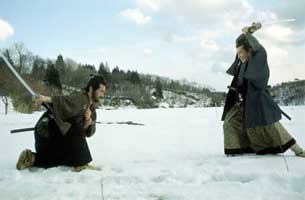 Three years later men of his province arrive in Edo & attempt to assassinate Magobei. Three years later men of his province arrive in Edo & attempt to assassinate Magobei.
He's too good a swordsman to be taken down; & while in the process of killing everyone who is trying to kill him, he finds out that Tatewaki is planning another disappearing village stunt, having a plan to cause a gold ship to crash upon a reef. Villagers will be forced to help, & then wiped out so that rumors will never be able to reach the bakufu.
Magobei sets off for home to intervene in the plan. He's obviously a hero in his quest to save the villagers, & will belatedly avenge those who were wrongly slain three years before. But his "enemy" is not really an evil man.
Conditions imposed on his lord by the bakufu have made it impossible for the clan to survive, & his grotesque acts are strictly in the name of duty to his lord & his hundreds of vassals. Getting that Sado gold into the clan's empty coffers will save many people from trouble.
Along the way Magobei meets the woman gambler whose life veered into ruin because of the destruction of her village. Magobei is also befriended by a happy-go-lucky ronin who claims always to "go where I smell money," but who is really a bakufu agent, played with endearing charm by Kinnosuke Nakamura. His smiling performance is in counterpoint to Nakadai's Magobei, a tragic-visaged fellow all but overwhelmed by the horrors he has witnessed, & by what he must do.
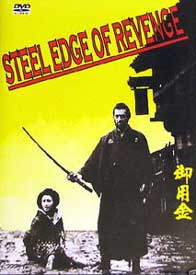 Nakadai has once again created a swordfighting style unique to his character. In Harakiri, his nearly indestructible ronin had a "crossed arms" stance. In Sword of Doom he had a stance that caused him to look off-balance & unprepared, luring his opponent to a speedy demise. And in Goyokin, he has peculiar posture with his bared sword pointing halfway behind him. Nakadai has once again created a swordfighting style unique to his character. In Harakiri, his nearly indestructible ronin had a "crossed arms" stance. In Sword of Doom he had a stance that caused him to look off-balance & unprepared, luring his opponent to a speedy demise. And in Goyokin, he has peculiar posture with his bared sword pointing halfway behind him.
I have to assume Nakadai creates these visual character portraits himself since he has done it with so many different directors. His shakespearean training & his awareness of posture in conveying character makes him one of the greatest screen presences the world has ever known, more than commonly suited to this type of period role.
The support performances from Kinnosuke Nakamura & Tetsuya Tamba further enrich this ode to samurai manliness, but it's Nakadai who makes it all come together.
There is beautifully choreographed swordplay action throughout, superb cinematography, & a straightforward story with striking incidents & intelligent consideration of repercussions.
The fact that nobody is an outright villain means there is tragedy no matter what the outcome, & before it's over, even the upbeat bakufu agent will regret serving a government whose policies result in so much catastrophe.
copyright © by Paghat the Ratgirl
|
